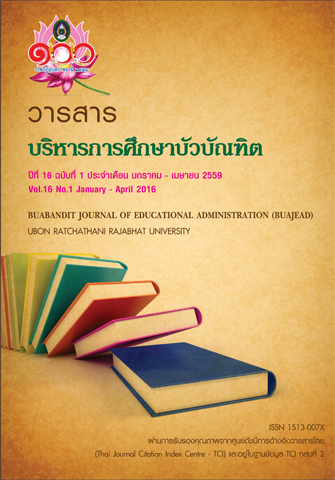การเปรียบเทียบความสามารถการอ่าน การเขียนภาษาไทย และการคิดวิเคราะห์ของนักเรียนชั้นประถมศึกษาปีที่ 1 ระหว่างการจัดการเรียนรู้ตามแนวคิดสมองเป็นฐานและการเรียนรู้ด้วยกลุ่มร่วมมือ
Main Article Content
บทคัดย่อ
Comparisons of Abilities in Reading, Writing for Thai Language and Analytical Thinking of Prathomsuksa 1 Students Between Who Learned Using Brain-Based Learning and Cooperative Learning Approaches
The purposes of this study were: 1) to develop plans for learning management based on Brain-Based Learning and cooperative Learning approaches in Thai Language of Prathomsuksa 1 level with the required efficiency of 75/75, 2) to find out effectiveness indices of those two plans for learning management, 3) to compare reading, writing abilities and analytical thinking between the students who learned based on those two different approaches. The sample used in this study consisted of 52 students from two classes of Prathomsuksa 1 level, attending from Jantharat Kindergarten school, Sahatsakhant District, under the Office of Kalasin Primary Educational Service Area Zone 1, in the academic year of 2014, which obtained using the cluster random sampling technique and random assigned for 26 students in each group using Brain-Based Learning approach and cooperative learning approach. The instruments used in the study were : 1) lesson plans for two types of learning management activities using Brain-Based Learning approach and cooperative learning approach in Thai language, taken for overall 20 hours with 20 plans in each approach; 2) test of reading ability were composed of 15-items for words reading, and 5-items for sentences reading, with the discriminating power of .33 – .61 and a reliability of scoring in reading assessment for 5 item test of .37 – .72 3) test of writing abilities were composed of 10 - items test for words writing, with discriminating power ranging .33-.61, 5-items test for sentences writing with a reliability of scoring assessing between .35-.63, and 5-items test for picture narrative writing, with a reliability of scoring assessing between .37-.62, and 4) a 20-items test of analytical thinking ability test with the difficulty ranging .33 - .67, the discriminating power ranging .31 - .73, and a reliability of .76. The statistics used for analyzing data were percentage, mean, standard deviation, and F-test (One-way MANOVA) was employed for testing the hypothesis. The results of the study were as follows : 1) The learning management plans using Brain-Based Learning approach and cooperative learning approach in Thai language for Prathomsuksa 1 level had efficiencies of 75.77/76.24 and 72.95/76.11 respectively. 2) The learning management plans using Brain- Based Learning approach and cooperative learning approach in Thai language for Prathomsuksa 1 level had the effectiveness indices of .5374 and .5369 respectively. Thus showed that the students who learned based on those of two approaches, had learning progress of 53.74 and 53.69 percents respectively. and 3) The students who learned using Brain-Based Learning and cooperative learning approaches in Thai language for Prathomsuksa 1 level, did not show difference of abilities in reading, writing for Thai language and analytical thinking.

